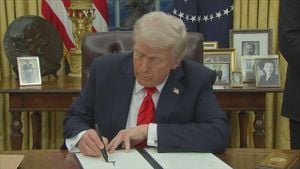The global economic stage is poised for significant shifts as former President Donald Trump re-enters the political arena with plans to reshape trade policies once again. With Trump’s recent election victory, the looming question on many economic analysts’ minds is what direction he will take with international commerce, particularly concerning the United States’ relationships with Canada and Mexico, two of its largest trading partners. Amidst speculation, both nations are strategically positioning themselves to curry favor with the incoming administration, setting the stage for potential tension as they navigate Trump’s trademark assertive negotiations.
According to reports, the leaders of Canada and Mexico are intensely competing for Trump's favor even before his inauguration. This rivalry isn’t just friendly banter; it’s underscored by Trump's history of implementing tariffs and threatening trade agreements to impose higher stakes on international negotiations. Trump has already indicated he might impose up to 25% tariffs on both countries, using the guise of tackling illegal immigration and drug trafficking as leverage. This strategy has drawn criticism, with many viewing it as classic “divide and conquer.”
Trump’s use of tariffs is not new; during his first term, he leveraged import duties to renegotiate trade deals. For starters, he replaced the North American Free Trade Agreement (NAFTA) with the United States-Mexico-Canada Agreement (USMCA), which was implemented to alter how trade flows were managed among the three nations. This involved smoothing over past grievances and creating new rules intended to protect various industries.
But the reality is complex. While the USMCA was believed to stabilize relations post-NAFTA, recent discussions surrounding potential tariffs could reignite economic tensions. Lila Abed, director of the Wilson Center’s Mexico Institute, noted, “With the announcements of tariffs... there is real concern over North American integration and free trade.” Experts worry these bold maneuvers could split alliances, leading to shifts away from regional cooperation.
Trump’s forthcoming policies will likely be seen through the lens of political performance, especially as he plays to his base, which tends to favor aggressive negotiation tactics. This has resulted in Canadian Prime Minister Justin Trudeau and Mexico's President Claudia Sheinbaum taking defensive postures. Sheinbaum’s sharp retorts to comments from the Canadian Ambassador highlight the tensions. She asserted the deep historical and cultural strengths of Mexico, saying, “Mexico has more than 3,000 years of history and civilizations,” signaling to the world—particularly the U.S.—that it should respect those roots.
Over the years, slow but steady adjustments have been made to create equitable trade environments across North America. The intent of USMCA was fundamentally to address perceived inequalities, but Trump’s renewed focus could lead to adjustments far beyond mere tweaks. The forecast for economic relations under Trump might bring back discussions about reviewing the agreement, which was signed with a specific clause to allow for amendments six years after its initiation.
Political dynamics on both sides of the border also present complications. Some Canadian politicians are adopting pro-American tones, with Conservative leader Pierre Poilievre pushing forward on a Canada-first agenda, emphasizing protectionist policies. He boldly declared, “I only care about Canada,” reflecting sentiments rooted deeply within his party’s platform. This approach could lead to more isolated tactics, where Canada opts for bilateral negotiations with the U.S. instead of collaborative strategies with Mexico.
Still, trade dynamics also remain dependent on local economies. Many politicians, particularly those representing states with strong trade ties to Mexico, caution against harsh rhetoric. Texas Democrat Rep. Joaquin Castro stated, “Trade with Mexico and Canada supports millions of jobs,” emphasizing the importance of maintaining positive trading relationships rather than igniting trade wars.
Trump’s policies could be met with pushback domestically, as pressure mounts from lobbyists and businesses who might be affected by trade disputes. Industries heavily reliant on cross-border trade, including agriculture and manufacturing, stand to lose if tariffs escalate. Their argument will center on sustaining the massive job markets fueled by this trade, with millions of American jobs linked to exports to these neighbors.
This situation is mirrored by economic indicators showing how much the U.S. economy relies on its neighbors, with over 60% of Canadian trade linked to the U.S. Therefore, as tensions rise, the risk of retaliation could strain these bonds significantly. There’s already talk of potential risks for sectors such as agriculture, which fear retaliatory tariffs impacting their export capabilities.
Looking globally, Trump's planned policies may have even broader consequences, with countries beyond North America watching closely. Will they see this as an invitation to adopt similar aggressive stances, or will it catalyze calls for more collaborative approaches to trade? The international balance of power could be at stake, depending on how these circumstances evolve.
Throughout all this, it’s perhaps worth asking: Is Trump’s approach detrimental to the notion of free trade, or does it present new opportunities for renegotiation? Questioning the status quo can yield valuable results or lead to heightened hostilities, so time will tell how Trump's administration will approach the delicate web of international commerce. With other nations potentially following suit, the stakes are significantly higher now than ever—a situation capable of altering the global economic order.
For now, Canada and Mexico find themselves on high alert, as both countries weigh their responses and scramble to solidify their stances. The upcoming weeks will reveal just how these trade relationships will be reshaped, with all eyes on the new, albeit familiar, faces of power.



